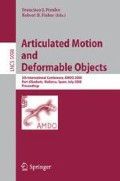Abstract
People with disabilities can benefit greatly from services provided by computers and robots. Access to remote communications and information as well as to interpersonal communication and environmental control are assisted by current ubiquitous computers, wired and wireless networks and intelligent environments. Sensory, physical or/and cognitive restrictions to interacting with computers can be avoided by means of alternative interaction devices and procedures. Nevertheless, alternative methods are usually much slower than standard communications, frequently leading users with disabilities into unbalanced or unsafe situations. Therefore, the main challenge of human-machine interaction systems that have to be used by people with disabilities is to obtain the maximum communication and control with the minimum physical and cognitive effort from the user. This lecture overviews the main techniques used to optimize the control and communication flow, resulting in higher user satisfaction and security.
Access this chapter
Tax calculation will be finalised at checkout
Purchases are for personal use only
Preview
Unable to display preview. Download preview PDF.
References
Abascal, J., Civit, A., Falcó, J.L.: Threats and opportunities of rising technologies for Smart Houses. In: Accessibility for All CEN-CENELEC-ETSI Conference 2003, Nice (2003)
Casals, A.: Assistant Robots. In: Casals, A. (ed.) Technological Aids for the Disabled. Societat Catalana de Technologia/Institut d’Estudis Catalans, Barcelona (1998)
Pons, J.L. (ed.): Wearable Robots. Biomechatronic Exoskeletons, pp. 87–108. Wiley, Chichester (2008)
Fink, J., Kobsa, A., Nill, A.: Adaptable and Adaptive Information Provision for All Users. Including Disabled and Elderly People. New Review of Hypermedia and Multimedia 4, 163–188 (1998)
Abascal, J., Lazkano, E., Sierra, B.: Behavior-based Indoor Navigation. In: Cai, Y. (ed.) Ambient Intelligence for Scientific Discovery. LNCS (LNAI), vol. 3345, pp. 263–285. Springer, Heidelberg (2005)
Cook, A.M., Hussey, S.: Assistive Technologies: Principles and Practice. In: Control interfaces for Assistive Technology, 2nd edn., ch. 6, Mosby (2001)
Rao, R.S., Conn, K., Jung, S.H., Katupitiya, J., Kientz, T., Kumar, V., Ostrowski, J., Patel, S., Taylor, C.J.: Human robot interaction: application to smart wheelchairs. In: Procs of ICRA 2002. IEEE Int. Conf. on Robotics and Automation, vol. 4, pp. 3583–3588 (2002)
Simpson, R.C., Levine, S.P.: Adaptive shared control of a smart wheelchair operated by voicecontrol. In: Proceedings of the 1997 IEEE/RSJ International Conference on Intelligent Robots and Systems, vol. 2(7-11), pp. 622–626 (1997)
Millán José del, R.: Adaptive brain interfaces. Comms of the ACM 46(3) (2003)
Abascal, J., Gardeazabal, L., Garay, N.: Optimisation of the Selection Set Features for Scanning Text Input. In: Miesenberger, K., Klaus, J., Zagler, W., Burger, D. (eds.) ICCHP 2004. LNCS, vol. 3118, pp. 788–795. Springer, Heidelberg (2004)
Garay-Vitoria, N., Abascal, J.: Text Prediction Systems: A survey. Universal Access in the Information Society (UAIS) 4(3), 188–203 (2006)
Vicente, S., Amaya, C., Díaz, F., Civit, A., Cagigas, D.: TetraNauta: A Intelligent Wheelchair for Users with Very Severe Mobility Restrictions. In: Procs. of the 2002 IEEE International Conference on Control Applications, pp. 778–783 (2002)
Abascal, J., Cagigas, D., Garay, N., Gardeazabal, L.: Mobile Interface for a Smart Wheelchair. In: Paternó, F. (ed.) Mobile HCI 2002. LNCS, vol. 2411, pp. 373–377. Springer, Heidelberg (2002)
Abascal, J., Bonail, B., Cagigas, D., Garay, N., Gardeazabal, L.: Trends in Adaptive Interface Design for Smart Wheelchairs. In: Lumsden, J. (ed.) Handbook of Research on User Interface Design and Evaluation for Mobile Technology. Idea Group Reference, Pennsylvania (2008)
Author information
Authors and Affiliations
Editor information
Rights and permissions
Copyright information
© 2008 Springer-Verlag Berlin Heidelberg
About this paper
Cite this paper
Abascal, J. (2008). Users with Disabilities: Maximum Control with Minimum Effort. In: Perales, F.J., Fisher, R.B. (eds) Articulated Motion and Deformable Objects. AMDO 2008. Lecture Notes in Computer Science, vol 5098. Springer, Berlin, Heidelberg. https://doi.org/10.1007/978-3-540-70517-8_44
Download citation
DOI: https://doi.org/10.1007/978-3-540-70517-8_44
Publisher Name: Springer, Berlin, Heidelberg
Print ISBN: 978-3-540-70516-1
Online ISBN: 978-3-540-70517-8
eBook Packages: Computer ScienceComputer Science (R0)

